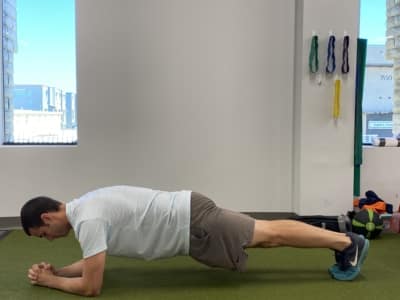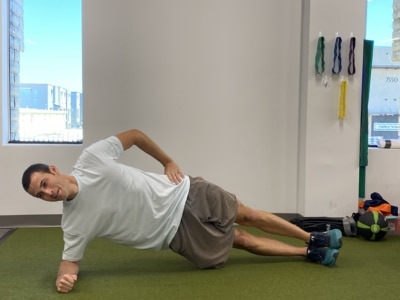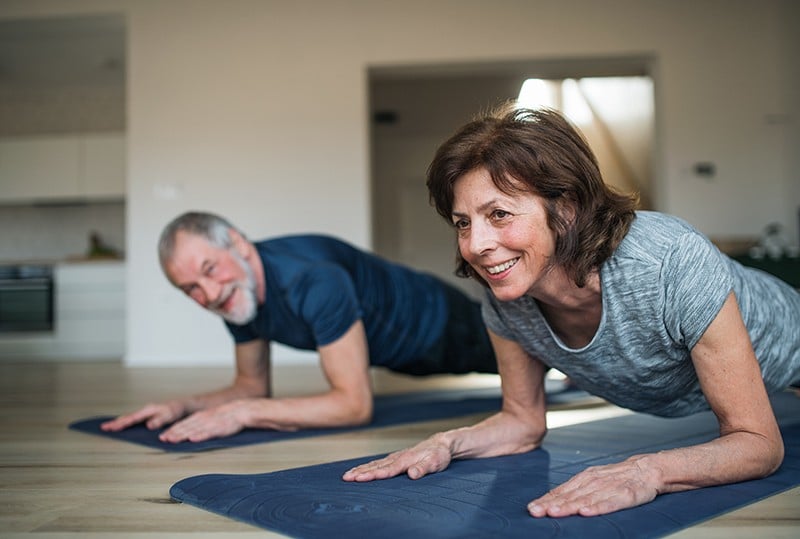The world may feel a little unstable right now, but your core doesn’t have to be. Try these core exercises to strengthen your entire self. Think you know where your core is? “It’s not just the abdominals,” says Spooner physical therapist Ryne Foster, PT, DOTS, OCS, FAFS, Cert. VRS. “The core is actually from the pelvic floor all the way up to the diaphragm, and everything in between, including the glutes and lower back muscles.” A strong core means a strong foundation and can help prevent muscle weakness, muscle imbalance, and injury. In addition, many of us sit for long periods during the day, which can lead to tightness in our hips, hip flexors, and hamstrings. This can compromise mobility and function throughout the body. You can’t just work the front to have a strong core. “You can do 1,000 crunches and not have a strong core,” Ryne says. “You actually need to do other exercises, including some glute strengthening and some balance training. Those are going to be so entwined.”
So, how do you properly build this critical foundation?
Your focus should be on exercises that promote mobility and strength. “In life, we squat, we bend, we twist, we move in all kinds of directions and positions,” Ryne says. A strong core will support us through all the variety of movements we do in our day-to-day lives, whether it’s getting out of bed, lifting and hauling groceries from the car to the kitchen, picking kids up off the floor, or restraining the leash of an extra-enthusiastic dog.
Bodyweight Core Exercises – Designed to Engage Your Core
Here are 6 bodyweight core exercises you can do at home. You might already be familiar with many of these exercises, but here are some tips to ensure you are performing them correctly.
1) Squats
Directions: Begin standing with a chair behind you, with your feet shoulder-width apart. Engage your core, keep your shoulder blades down and back, and maintain a neutral spine throughout the exercise. (Neutral does not mean vertical – you can lean forward from your hips. Do not arch your lower back). Sit your bottom back, keeping most of your weight in your heels as you bend at your knees and hips with control. Do not let your knees move beyond your toes by trying to keep your lower legs as vertical as possible. Do not allow your knees to move inward. Keep your chest facing forward to avoid rounding your spine. Repeat as prescribed.
Tip: Place your arms out in front of you as you descend for balance.
2) Lunges
Directions: Start in a standing position. Remember to breathe – inhale, exhale. Step forward with your right leg and bend your left knee to perform a lunge motion. Repeat on your left leg.
3) Front Plank and Side Plank with Variations
Basic Front Plank
Directions: Begin by lying on your stomach with both forearms under your chest. Keeping your abdominals tight, push up through your forearms so that your chest, hips, and knees are off the ground. You should be able to draw a straight line from your ankles, through your hips to your shoulders. Hold the position. Start with a 10-15 second plank and progress from there.

Front Plank
Basic Side Plank
Directions: Lying on your side with your elbow and forearm under your shoulder, lift your hips off the floor, keeping your abdominals tight. Make sure to keep your body as straight as possible and hold. Start with a 20 second plank on your right side. Rotate to complete a 20 second plank on your left side.

Side Plank
Read more about ways to strengthen your core in “How to Achieve a Strong Core” on the Spooner Blog.
4) Seated and Standing Reach Matrix
Directions: Twist, rotate, and reach in a seated or standing position to lubricate the spine and ease pain during the day.
5) Torso Rotation and Chop/Lift
Standing Trunk Rotations with Resistance Band Directions: Begin by placing an exercise band securely in a doorway at chest height. Make sure to take out all of the slack by stepping further away from the doorway if needed. Standing perpendicular to the doorway with both arms out in front of you, rotate your body away from the door, and then rotate back to the starting position. Repeat as directed.
Chops with Resistance Band Directions: Begin by placing an exercise band securely in the top of a doorframe. While standing with your side to the door, grab the end of the band and grasp both hands together. With your elbows straight, lift both arms up and to the side of your head on the side closest to the doorway. Slowly bring your arms down and across your body, following with your head and shoulders. Once fully crossed, slowly return to the starting position. Focus on turning your entire body and rotating your hips. Repeat as directed.
Lifts with Resistance Band Directions: Grasp hands together and start with them next to one hip. Lift both hands up and across your body, keeping hips pointed forward and rotating at the upper back. During rotation focus on also rotating hips and the total body. Repeat as directed.
6) Hip Flexor Stretch
Directions: Begin in a kneeling position, with your knees shoulder width apart. If needed, place a mat or pad under your knees for comfort. Place one foot flat on the ground in front of you, and make sure your foot is in line with the same side shoulder. To perform a posterior pelvic tilt, tuck your hips underneath you. Shift your weight forward until you feel a stretch across the front of your leg kneeling on the ground. Maintain this position and move your pelvis through 3 patterns: 1) Move your pelvis forward and backward. 2) Move your pelvis side to side. 3) Rotate your pelvis toward the right and left. Tip: Make sure you maintain a stretch across the front of your kneeling leg throughout the exercise.
Would you like some help creating a core routine that will ensure you have a solid foundation? Get started today, schedule and appointment or complimentary assessment at Spooner Physical Therapy.

